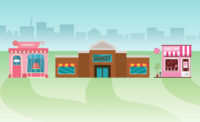Willard Bishop recently released its 2015 eCommerce SuperStudy, highlighting opportunities in online grocery shopping. Key insights include a list of top-tier CPG manufacturers that are winning the fair-share-battle for product sales within the digital marketplace.
In order to gain some insight into the SuperStudy and the current state of e-commerce, we reached out to Paul Weitzel, managing partner of Willard Bishop, Barrington, IL.
Douglas J. Peckenpaugh: What are some of the top-level findings from the 2015 eCommerce SuperStudy? What is the state of e-commerce in the U.S.?
Paul Weitzel: E-commerce is a $25 billion dollar industry in the U.S. and growing double digits annually. Food and beverage is lagging other channels, but is quickly gaining ground. Grocers believe it’s really here to stay and are adding pickup points every day. Discussions are now focused on answering the big question, What does the future fulfillment model look like that makes e-commerce a profitable and sustainable service?
Center-store food and non-food categories are doing very well online. Temperature state, i.e., frozen, refrigerated, is not an issue. Having someone pick out your fresh product is not an issue. It’s here to stay and will only grow. Baskets are large, averaging $140 to $160.
DJP: Have U.S. retailers begun to embrace the omnichannel model?
PW: Not yet in Grocery. Building a seamless system where orders can be made on a PC, tablet, phone or even an in-store kiosk is just starting in other channels like clothing. Grocery systems are not sophisticated enough yet.
DJP: How have consumer attitudes on e-commerce and food changed?
PW: More and more, consumers are accepting someone else picking out their groceries. Retailers can’t afford to have product returned in an e-commerce environment, so they spend the time to select the freshest product possible. Consumers are satisfied with product selection and consumers are pleased. With the aging of America, home deliveries will continue to become more common and will grow.
The biggest complaints retailers get today has to do with long delivery windows where consumers have to be home sometimes up to 2 hours. A lot of people don’t like waiting around for an order that has a 2 hour delivery window. That will also get better as retailers continue to move closer to on-demand deliveries. I believe that is the future for local grocers.
DJP: What are the strongest categories of food today in e-commerce?
PW: Center store food and non-food categories over index online. Snacks and packaged bakery products also do very well. They are among the top sellers online.
Online shoppers shop more of the store today than traditional in-store shoppers. Baskets are 5 times larger.
DJP: Can some types of product manufacturers effectively compete with retailers by offering products for sale online directly to consumers?
PW: It’s being done today. Companies like P&G offer direct-to-home deliveries already. I don’t think this will become a competitive issue. Online grocers will continue to get better, and deliveries will continue to move to on-demand fulfillment. Hard to beat that when a store is 2 miles away and they will deliver same day or, eventually, in one hour.
DJP: What are the hurdles e-commerce faces in terms of increasing online sale of food products?
PW: First, we have to do a better job identifying the right assortment levels for online grocery shopping. Many retailers make every item in the store available online. Navigating through 40,000 SKUs is not easy for consumers. Second, we need to continue to improve how category navigation is set up for online shopping. Navigation often doesn’t match how consumers shop online. We need to match the right attributes by category with click-through navigation, e.g., right sequence of brand, flavor, type, health, etc. Third, we need to personalize web pages more based on each customer’s sales history, product loyalty, price sensitivities, etc. Personalization is going to be key, and it will be a driver for long-term success and growth. Consumers are definitely willing to pay for convenience, now we just need to make it more convenient.
DJP: How might the idea of households placing standing, customizable monthly orders of staple goods, including food, help build consumer confidence in e-commerce and product home delivery?
PW: I do believe we will see more auto orders as experience with the programs grow. Households are ordering every 15 days, and we will see auto-replenishment only grow. The fear of having someone else pick out fresh product is really over. The biggest challenge we still have though is a lot of fresh purchase decisions are made in-store vs. before going to a store. And, it’s not easy to shop fresh online right now. It will get better as online systems improve.
I think we will see a lot of center-store purchases done online, and then consumers will shop the store for fresh. In many cases, we could even see fresh purchased in the store and then shoppers drive around to an express lane to pick up the center-store orders that were placed earlier online. This will save time on the routine purchases.
DJP: How can manufacturers and/or retailers better position e-commerce models to spur more ecommerce revenue for products like shelf-stable snacks and baked goods?
PW: Product positioning online right now is challenging. The click-through navigation will improve, and pages will be personalized more in the near future to make the experience easier for each individual shopper. Manufacturers need to work closer with the online grocers and even the software vendors to ensure their categories are organized better so navigation is easier and setup based on how customers shop online. Still a lot of work to be done in this area.





